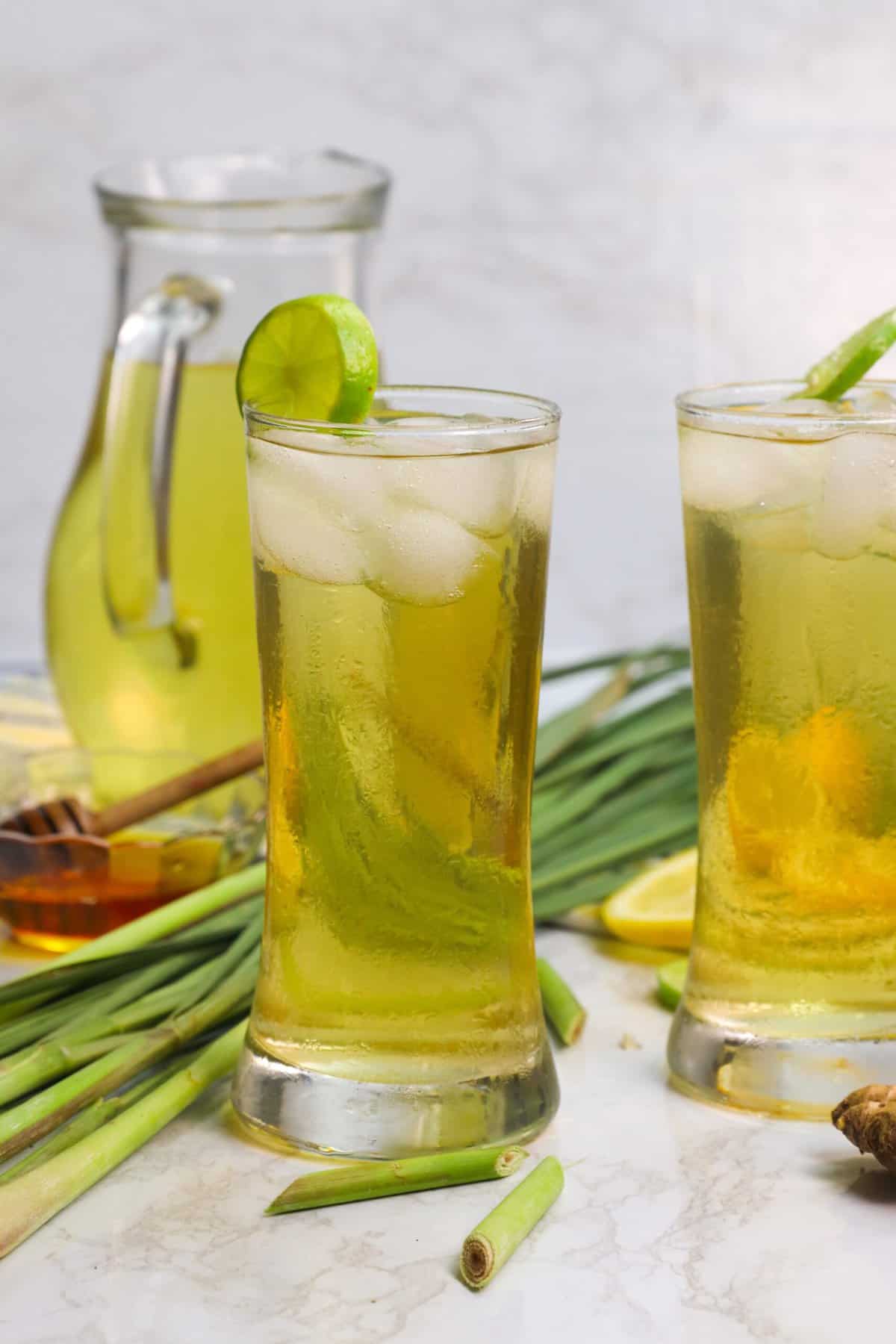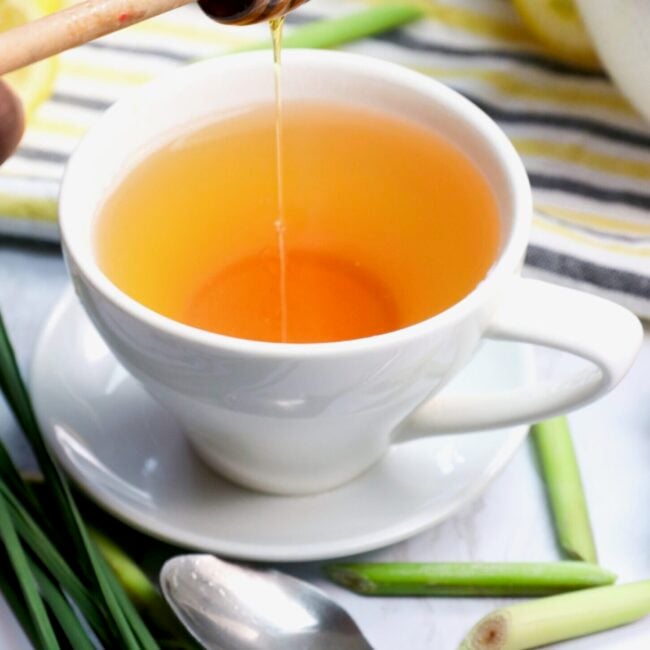Lemongrass Tea – Fragrant lemongrass, zesty lemon, and natural sweeteners blend harmoniously to create a soothing, flavorful beverage. It’s great, hot or cold, and it’s a healthy, delicious way to start your day or wind down in the evening. All you need is a handful of ingredients to enjoy this refreshing treat!

In the world of herbs, oregano, basil, and parsley get a lot of attention. But I’ve always been a huge fan of lemongrass. In fact, lemongrass tea has been a constant at my house since I started growing it on my patio. Hot lemongrass tea is soothing and comforting on cool evenings and equally delicious over ice.
So, when the heat of summer hit last year, my son and I started making big batches of lemongrass tea and chilling it in the fridge. We drink it in the morning to kickstart our day or enjoy it hot in the evening to relax and unwind. With its vibrant flavor and aroma, it’s pretty much happiness in a cup!

Lemongrass Tea Benefits
I’m not a doctor, but I’ve heard that lemongrass is really good for us. My personal experience is that it’s very relaxing. While native to Asia, it grows very well in my beloved Africa.
According to WebMD, it’s rich in antioxidants, may be great for digestion, and could lower cholesterol levels and heart disease. Some people love putting lemongrass essential oil in their lotion, swearing it helps their skin. It definitely smells good.
Recipe Ingredients

- Lemongrass – The star player! I use both the stalks and the leaves for optimal flavor.
- Ginger – This is optional, but ginger’s tang complements lemongrass beautifully. Fresh ginger root or ground ginger both work fine.
- Sweetener – I love natural sweeteners like honey or maple syrup. However, brown sugar also goes well with lemongrass.
- Citrus – Lemon and lime add a zesty kick and a citrus boost. I think orange would also go well.
How to Make Lemongrass Tea

- Wash – Rinse and remove any dry or tough outer layers from the lemongrass stalks and leaves.
- Chop – Cut the stalk’s root end and upper part off, leaving the tender, pale-yellow base and the green upper part. On a cutting board, finely chop the stalks into smaller pieces. Slice the ginger. (Photos 1-2)
- Twist – Fold the leaves into a length that will fit the pot you are using and twist. Twisting releases more flavor from the lemongrass.
- Boil Water – Fill a pot with water based on the number of cups you intend to brew and how strong you want your tea to be. Place the pot on the stove and bring the water to a rolling boil.
- Steep – Once the water reaches a boil, add the chopped lemongrass stalks, twisted leaves, and sliced ginger to the pot. Lower the heat to medium-low and simmer for 5-10 minutes. (Photo 3)
- Strain – Take the pot off the heat and carefully pour the tea through the strainer, discarding the lemongrass pieces and ginger slices. (Photo 4)
- Serve – Pour the tea into a teacup and add sugar or honey to taste. You could squeeze a bit of lemon juice and garnish it with lemon or lime wedges. Stir gently to combine the ingredients, ensuring that the flavors are well-distributed.
Recipe Variations
- Iced. For a refreshing iced version, allow the tea to cool after straining, then refrigerate it. Pour your tea over ice and garnish it with lemon slices or fresh mint leaves.
- Bubbly. Halve the amount of water for steeping. Then, add a glug of sparkling water to the cold tea for a bubbly beverage.
- Golden tea. Add a sprinkle of turmeric or cinnamon to the tea to get a beautiful golden tone. It’s also a great way to boost the number of antioxidants!
- Green tea. Add a spoonful of green tea leaves or a tea bag to the tea after taking it off the heat. Let them steep together for extra health benefits.
- Garnish. If you have extra lemongrass stalks, clean them up and use them to stir the sweetener in your tea.
Tips and Tricks
- Make sure your fresh lemongrass stalks and leaves are firm and vibrant green for the tastiest tea. If you use dried, make sure it still smells like lemongrass. If you can’t smell it, you probably won’t taste it, either.
- You can refrigerate leftover lemongrass stalks in a sealable plastic bag for two weeks or freeze them for months. You can mince the stalks for various dishes, like this mouthwatering braised chicken in coconut milk.
- To get maximum flavor and aroma, bruise the lemongrass before adding it to the water. Crush the leaves lightly with the back of your knife to release the natural oils and aroma.
- Growing your own lemongrass plant is super easy. If you have a sunny patio or window, it’s the perfect houseplant that gives to you. 😍
Make-Ahead Instructions
Making lemongrass tea only takes a few minutes, so you can boil up a batch whenever your taste buds desire!
If you love cold tea, make it ahead, let it cool on the counter, and then store it in refrigerate. You can also freeze some of the tea in an ice cube tray to make ice tea without watering it down.

Serving and Storage Instructions
Serve hot or cold to close out a delicious meal or accompany an afternoon snack. Leftover lemongrass tea stores beautifully in the refrigerator for 3 days. You can reheat the refrigerated tea in the microwave if you prefer hot tea.
FAQs
You can use fresh, dried, or frozen lemongrass for this tea. I won’t tell. 😉 Use half as much dried lemongrass and the same amount of frozen.
Yes! This recipe serves 6 people. If you’d like to make more tea, double the recipe or adjust the ingredients according to your needs. The ratio is approximately one lemongrass stalk per cup of water, then sweeten according to your palate.
No, this is an herbal tea, so it is naturally caffeine-free. Yay!
What to Serve With Lemongrass Tea
I love to unwind at the end of a busy day with a cup of lemongrass tea and a cranberry orange scone or lemon blueberry scone. Biscotti and ambrosia salad are also perfect for a late-afternoon treat on the patio!
More Refreshing Beverages to Try
Conclusion
Take a break from your busy day and indulge in this soothing lemongrass tea treat! Do you prefer to drink lemongrass tea hot or cold? Leave me a comment below with your thoughts!
Watch How to Make It
Homemade Lemongrass Tea
Ingredients
- 5 stalks lemongrass, use stalks and leaves (more or less, depending on your tastes)
- 6 cups water
- 1 tablespoon sliced ginger (optional)
- honey or sugar to taste
- lemon wedges or lime wedges for garnish and added flavor
Instructions
- Rinse and remove any dry or tough outer layers from the lemongrass stalks and leaves.
- Cut off the stalk's root and upper ends, leaving the tender, pale-yellow base and green upper portion.
- On a cutting board, finely chop the stalks into smaller pieces.
- Fold the lemongrass leaves into a length that will fit into a pot and twist them to release more flavor.
- Fill the pot with water based on the number of cups you intend to brew and how strong you want your tea.
- Place the pot on the stove and bring the water to a rolling boil.
- Once the water reaches a boil, add the chopped lemongrass stalks, twisted leaves, and sliced ginger.
- Reduce the heat to medium-low and simmer the lemongrass gently in the water for 5-10 minutes.
- Remove the pot from the heat and carefully pour the tea through the strainer, discarding the lemongrass pieces and ginger slices.
- Pour the tea into your teacup and sweeten it to taste with sugar or honey. A splash of lemon juice and garnish it with lemon or lime wedges is also good.
- Stir gently to combine the ingredients, ensuring that the flavors are well-distributed.
Tips & Notes:
- Make sure your fresh lemongrass stalks and leaves are firm and vibrant green for the tastiest tea. If you use dried, make sure it still smells like lemongrass. If you can’t smell it, you probably won’t taste it, either.
- You can refrigerate leftover lemongrass stalks in a sealable plastic bag for two weeks or freeze them for months. You can mince the stalks for various dishes, like this mouthwatering braised chicken in coconut milk.
- To get maximum flavor and aroma, bruise the lemongrass before adding it to the water. Crush the leaves lightly with the back of your knife to release the natural oils and aroma.
- Growing your own lemongrass plant is super easy. If you have a sunny patio or window, it’s the perfect houseplant that gives to you.
- Please remember that the nutritional information is a rough estimate and can vary significantly based on the products used in the recipe.

Leave a Review